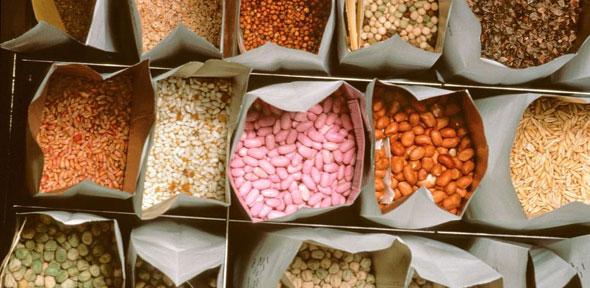
Endangered Maize: Indigenous Corn, Industrial Agriculture and the Spectre of Extinction
July 2017–July 2020
This three-year project, supported by a CRASSH ProFutura Scientia Fellowship, pursues the history of an unlikely conservation concern: that of Zea mays, also known as corn or maize. Increases in agricultural production have for more than a century been accompanied by breeding and cultivation strategies that emphasize uniformity, predictability, and yield. These strategies tend to diminish the diversity of corn in cultivation worldwide. This is a problem, given that most observers think the future of corn depends on the survival of at least some of its vast genetic diversity and some of its diverse modes of cultivation against the seeming monoliths of genetic homogenization and industrialization. As a result, efforts to gather and protect this diversity, to catalogue and understand it, to conserve and preserve it, and even to defend it, have been ongoing for more than a century. These efforts have been undertaken more and less deliberately, with widely varying aims and agendas, sometimes succeeding spectacularly and other times failing miserably.
The project Endangered Maize seeks to produce a first-ever history of these efforts, and to explore their consequences for today's agriculture. It follows the intertwined histories of many agriculturists in the United States, Mexico, and beyond, who have worried about the survival of this ubiquitous crop plant. It looks to the aspirations of farmers managing the flat unending fields of hybrid corn in the central United States as well as those tending terraced, mixed cultivation farms of the Mexican highlands. It documents the hopes of plant breeders at state agricultural institutions responsible for improving national corn production alongside those of international scientists tasked with saving precious global resources. It examines the contributions of plant hunters tracking down indigenous farmers to gather their 'native' corn, technicians stewarding vast collections of varieties in genebanks, and boardroom bigwigs holding the purse strings for conservation work. As it follows these individuals and their ideas, the book attends to the continued entanglement of concerns about the endangerment and vulnerability of Zea mays – and the communities dependent upon it – with the spread of industrial corn cultivation, first in the United States, then across Latin America, then around the world.
People
- Helen Anne Curry, CRASSH ProFutura Scientia Fellow
Publications
'From Working Collections to the World Germplasm Project: Agricultural Modernization and Genetic Conservation at the Rockefeller Foundation', History and Philosophy of the Life Sciences 39, no. 5 (June 2017), special issue on 'New Perspectives in the History of the Twentieth Century Life Sciences', ed. Kärin Nickelsen and Robert Meunier. [OA Repository.]
'Breeding Uniformity and Banking Diversity: The Genescapes of Industrial Agriculture, 1935–1970', Global Environment 10, no. 1 (April 2017), special issue on 'Manufacturing Landscapes: Nature and Technology in Environmental History', ed. Helmuth Trischler and Don Worster. [OA Repository.]
Seeds for Survival: A Global History of Seed Banking
Since the 1960s, governments, international organizations, NGOs, and private philanthropies have invested heavily in the conservation of genetic diversity in plant species, especially agricultural crops. The most visible marker of this investment has been the proliferation of 'seed banks', institutions dedicated to the collection and preservation of seeds. These serve as permanent repositories for the world's vast genetic diversity in food crops and, increasingly, its diversity in wild plants as well.
This project investigates the history of seed banking as a global conservation practice and human health imperative. Through this project, we seek to understand: how the genetic diversity of plant species came to be seen as a critical but imperilled resource essential to human survival; how seed banks came to be seen as the obvious solution to the threat of losing such diversity; and the consequences of these ideas – and the institutions and activities they inspired – for global food security and human wellbeing in the present.
This work has been supported by a seed award from the Wellcome Trust, with smaller grants from the Rockefeller Archive Center and the Centre for Research in the Arts, Social Sciences and Humanities at the University of Cambridge.
People
- Helen Anne Curry, Principal Investigator
- Sara Peres, Postdoctoral Research Assistant, 2016–2017
Publications
'To Save a Seed: The Collection and Conservation of Plant Genetic Resources, Past and Present', Special Issue of Culture, Agriculture, Food and Environment, forthcoming December 2019.
- Contributions:
- Xan Chacko, 'Creative Practices of Care: The Subjectivity, Agency and Affective Labour of Preparing Seeds for Long-term Banking'
- Helen Anne Curry, 'Garden Variety Diversity: Conserving Vegetable Heritage at the Henry Doubleday Research Association, 1970–1985'
- Kay Lewis-Jones, '"The first step is to bring it into our hands": wild seed conservation, the stewardship of species survival and gardening the Anthropocene at the Millennium Seed Bank Partnership'
- Sara Peres, 'Securing germplasm, duplicating seeds: vulnerability in the history of seed banking'
'Imperilled Crops and Endangered Flowers', in H. A. Curry, N. Jardine, J. A. Secord, and E. C. Spary, eds., Worlds of Natural History (Cambridge: Cambridge University Press, 2018).
'From Bean Collection to Seed Bank: Transformations in Heirloom Vegetable Conservation and the Fate of Burt Berrier's Beans', forthcoming in BJHS Themes, 'How Collections End', edited by Jenny Bangham, Boris Jardine and Emma Kowal.
